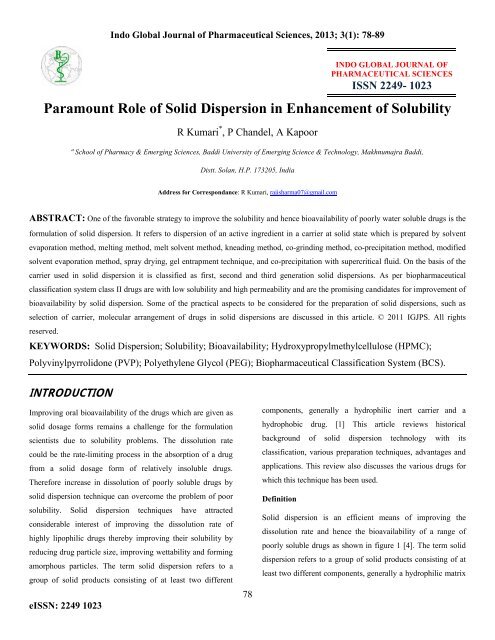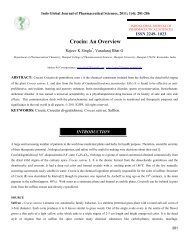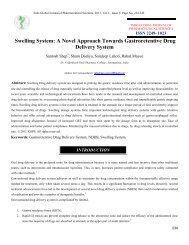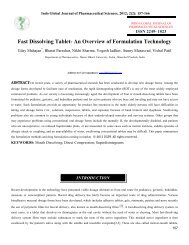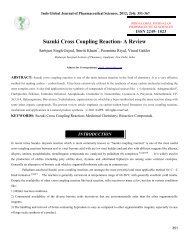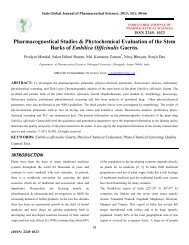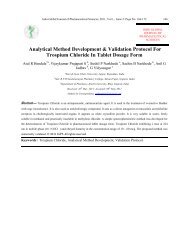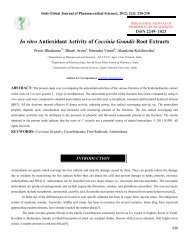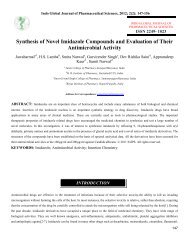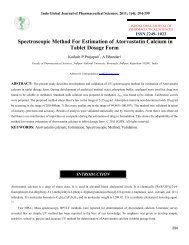Paramount Role of Solid Dispersion in Enhancement of Solubility
Paramount Role of Solid Dispersion in Enhancement of Solubility
Paramount Role of Solid Dispersion in Enhancement of Solubility
Create successful ePaper yourself
Turn your PDF publications into a flip-book with our unique Google optimized e-Paper software.
Indo Global Journal <strong>of</strong> Pharmaceutical Sciences, 2013; 3(1): 78-89<br />
<strong>Paramount</strong> <strong>Role</strong> <strong>of</strong> <strong>Solid</strong> <strong>Dispersion</strong> <strong>in</strong> <strong>Enhancement</strong> <strong>of</strong> <strong>Solubility</strong><br />
R Kumari * , P Chandel, A Kapoor<br />
INDO GLOBAL JOURNAL OF<br />
PHARMACEUTICAL SCIENCES<br />
ISSN 2249- 1023<br />
a<br />
School <strong>of</strong> Pharmacy & Emerg<strong>in</strong>g Sciences, Baddi University <strong>of</strong> Emerg<strong>in</strong>g Science & Technology, Makhnumajra Baddi,<br />
Distt. Solan, H.P. 173205, India<br />
Address for Correspondance: R Kumari, rajisharma07@gmail.com<br />
ABSTRACT: One <strong>of</strong> the favorable strategy to improve the solubility and hence bioavailability <strong>of</strong> poorly water soluble drugs is the<br />
formulation <strong>of</strong> solid dispersion. It refers to dispersion <strong>of</strong> an active <strong>in</strong>gredient <strong>in</strong> a carrier at solid state which is prepared by solvent<br />
evaporation method, melt<strong>in</strong>g method, melt solvent method, knead<strong>in</strong>g method, co-gr<strong>in</strong>d<strong>in</strong>g method, co-precipitation method, modified<br />
solvent evaporation method, spray dry<strong>in</strong>g, gel entrapment technique, and co-precipitation with supercritical fluid. On the basis <strong>of</strong> the<br />
carrier used <strong>in</strong> solid dispersion it is classified as first, second and third generation solid dispersions. As per biopharmaceutical<br />
classification system class II drugs are with low solubility and high permeability and are the promis<strong>in</strong>g candidates for improvement <strong>of</strong><br />
bioavailability by solid dispersion. Some <strong>of</strong> the practical aspects to be considered for the preparation <strong>of</strong> solid dispersions, such as<br />
selection <strong>of</strong> carrier, molecular arrangement <strong>of</strong> drugs <strong>in</strong> solid dispersions are discussed <strong>in</strong> this article. © 2011 IGJPS. All rights<br />
reserved.<br />
KEYWORDS: <strong>Solid</strong> <strong>Dispersion</strong>; <strong>Solubility</strong>; Bioavailability; Hydroxypropylmethylcellulose (HPMC);<br />
Polyv<strong>in</strong>ylpyrrolidone (PVP); Polyethylene Glycol (PEG); Biopharmaceutical Classification System (BCS).<br />
INTRODUCTION<br />
Improv<strong>in</strong>g oral bioavailability <strong>of</strong> the drugs which are given as<br />
solid dosage forms rema<strong>in</strong>s a challenge for the formulation<br />
scientists due to solubility problems. The dissolution rate<br />
could be the rate-limit<strong>in</strong>g process <strong>in</strong> the absorption <strong>of</strong> a drug<br />
from a solid dosage form <strong>of</strong> relatively <strong>in</strong>soluble drugs.<br />
Therefore <strong>in</strong>crease <strong>in</strong> dissolution <strong>of</strong> poorly soluble drugs by<br />
solid dispersion technique can overcome the problem <strong>of</strong> poor<br />
solubility. <strong>Solid</strong> dispersion techniques have attracted<br />
considerable <strong>in</strong>terest <strong>of</strong> improv<strong>in</strong>g the dissolution rate <strong>of</strong><br />
highly lipophilic drugs thereby improv<strong>in</strong>g their solubility by<br />
reduc<strong>in</strong>g drug particle size, improv<strong>in</strong>g wettability and form<strong>in</strong>g<br />
amorphous particles. The term solid dispersion refers to a<br />
group <strong>of</strong> solid products consist<strong>in</strong>g <strong>of</strong> at least two different<br />
eISSN: 2249 1023<br />
78<br />
components, generally a hydrophilic <strong>in</strong>ert carrier and a<br />
hydrophobic drug. [1] This article reviews historical<br />
background <strong>of</strong> solid dispersion technology with its<br />
classification, various preparation techniques, advantages and<br />
applications. This review also discusses the various drugs for<br />
which this technique has been used.<br />
Def<strong>in</strong>ition<br />
<strong>Solid</strong> dispersion is an efficient means <strong>of</strong> improv<strong>in</strong>g the<br />
dissolution rate and hence the bioavailability <strong>of</strong> a range <strong>of</strong><br />
poorly soluble drugs as shown <strong>in</strong> figure 1 [4]. The term solid<br />
dispersion refers to a group <strong>of</strong> solid products consist<strong>in</strong>g <strong>of</strong> at<br />
least two different components, generally a hydrophilic matrix
Indo Global Journal <strong>of</strong> Pharmaceutical Sciences, 2013; 3(1): 78-89<br />
Figure 1 Schematic representation <strong>of</strong> enhanced bioavailability <strong>of</strong> the drug by formulation <strong>of</strong> solid dispersion compared with<br />
conventional tablet/capsule. [4]<br />
Figure 2 Classification <strong>of</strong> solid dispersion.<br />
and a hydrophobic drug. The matrix can be either crystall<strong>in</strong>e<br />
or amorphous. The drug can be dispersed molecularly, <strong>in</strong><br />
amorphous particles (clusters) or <strong>in</strong> crystall<strong>in</strong>e particles. [2]<br />
Ideal Drug Candidates for <strong>Solid</strong> <strong>Dispersion</strong><br />
In the Biopharmaceutical Classification System (BCS) class II<br />
drugs are those with low aqueous solubility and high<br />
membrane permeability and therefore solid dispersion<br />
technologies are particularly promis<strong>in</strong>g for improv<strong>in</strong>g the oral<br />
absorption and bioavailability <strong>of</strong> BCS Class II drugs.<br />
Accord<strong>in</strong>g to the BCS, drug substances can be classified as<br />
belong<strong>in</strong>g to one <strong>of</strong> four classes as shown <strong>in</strong> table 1. It is<br />
obvious that for class II drugs the low ability to dissolve is a<br />
more important limitation to their overall rate and extent <strong>of</strong><br />
absorption then their ability to permeate through the<br />
membrane. Therefore, the formulation work for class II<br />
compounds should focus on the enhancement <strong>of</strong> aqueous<br />
solubility or dissolution rate. [3]<br />
CLASSIFICATION OF SOLID DISPERSION<br />
Classifications <strong>of</strong> solid dispersion on the basis <strong>of</strong> carrier used<br />
is described as follow<strong>in</strong>g and shown <strong>in</strong> figure 2.<br />
eISSN: 2249 1023<br />
79
Indo Global Journal <strong>of</strong> Pharmaceutical Sciences, 2013; 3(1): 78-89<br />
Table 1: BCS calssification system<br />
Class <strong>Solubility</strong> Permeability Example <strong>of</strong> drugs<br />
Class I High solubility High permeability<br />
Benzapril, Loxopr<strong>of</strong>en,<br />
Sumatriptan etc.<br />
Class II High solubility High permeability<br />
Valsartan, Nimesulide,<br />
Loratad<strong>in</strong>e, Acecl<strong>of</strong>enac,<br />
Glimepiride etc.<br />
Class III High solubility How permeability<br />
Gabapent<strong>in</strong>e, Topiramate,<br />
Atrop<strong>in</strong>e etc.<br />
Class IV Low solubility Low permeability<br />
Hydrochlorthiazide, Furosemide,<br />
Meloxicam etc.<br />
Carriers<br />
Sugars<br />
Acids<br />
Polymeric Material<br />
Insoluble or enteric polymers<br />
Surfactants<br />
Miscellaneous<br />
Table 2: List <strong>of</strong> carriers used <strong>in</strong> solid dispersion<br />
Examples<br />
Dextrose, sucrose, lactose, sorbitol, maltose, mannitol, galactose<br />
Citric acids, succ<strong>in</strong>ic acids<br />
Povidone, polyethylene glycol, hydroxyl propyl methyl cellulose, methyl cellulose, hydroxyl<br />
ethyl, cellulose, pect<strong>in</strong><br />
Hydroxy propyl methyl cellulose phthalate, Eudrgit RS<br />
Polyoxyethylene stearate, Renex, Poloxamer 188, Tex<strong>of</strong>or AIP, Deoxycholioc acid, Tweens,<br />
Spans<br />
Urea, Hydroxyalkylxanth<strong>in</strong>s, Urethans<br />
A. First generation<br />
First generation solid dispersions are prepared us<strong>in</strong>g<br />
crystall<strong>in</strong>e carriers such as urea and sugar, which were the first<br />
carriers to be employed <strong>in</strong> solid dispersion. They have the<br />
disadvantage <strong>of</strong> form<strong>in</strong>g crystall<strong>in</strong>e solid dispersion, which are<br />
thermodynamically more stable and did not release the drug as<br />
quickly as amorphous ones. [3]<br />
B. Second generation<br />
Second generation solid dispersions <strong>in</strong>clude amorphous<br />
carriers <strong>in</strong>stead <strong>of</strong> crystall<strong>in</strong>e carriers which are usually<br />
polymers. These polymers <strong>in</strong>clude synthetic polymers such as<br />
povidone (PVP), polyethyleneglycols (PEG) and<br />
polymethacrylates as well as natural product based polymers<br />
such ashydroxylpropylmethyl-cellulose (HPMC), ethyl<br />
cellulose, and hydroxypropoylcellulose or starch derivates like<br />
cyclodextr<strong>in</strong>s. [3]<br />
C. Third generation<br />
Recently, it has been shown that the dissolution pr<strong>of</strong>ile can be<br />
improved if the carrier has surface activity or self emulsify<strong>in</strong>g<br />
properties. Therefore, third generation solid dispersions<br />
appeared. The use <strong>of</strong> surfactant such as <strong>in</strong>ul<strong>in</strong>, <strong>in</strong>utec SP1,<br />
compritol 888 ATO, gelucire 44/14 and poloxamer 407 as<br />
carriers are<br />
shown to be effective <strong>in</strong> orig<strong>in</strong>at<strong>in</strong>g high<br />
polymorphic purity and enhanced <strong>in</strong> vivo bioavailability.[3]<br />
CRITERIA FOR SELECTION OF<br />
CARRIERS USED IN SOLID DISPERSION<br />
The selection <strong>of</strong> the carrier has the <strong>in</strong>fluence on the dissolution<br />
characteristics <strong>of</strong> the dispersed drug. A water soluble carrier<br />
results <strong>in</strong> a faster release <strong>of</strong> the drug from the matrix.<br />
Classification <strong>of</strong> carriers is shown <strong>in</strong> table 2. An <strong>in</strong>soluble<br />
carrier leads to slower release <strong>of</strong> a drug from the matrix. The<br />
carriers to be used should have the follow<strong>in</strong>g characteristics:<br />
[4]<br />
Sugars<br />
‣ Readily soluble <strong>in</strong> water and <strong>in</strong> gastro<strong>in</strong>test<strong>in</strong>al fluids<br />
‣ Physiologically <strong>in</strong>ert<br />
‣ Melt<strong>in</strong>g po<strong>in</strong>t not much higher than that <strong>of</strong> drug<br />
‣ Thermal stability at melt<strong>in</strong>g temperature<br />
‣ Low vapor pressure<br />
‣ High molecular weight<br />
‣ Non toxic<br />
Although sugars and related compounds are highly water<br />
soluble but few sugars have toxicity issues, they are less<br />
suitable than other carriers for the manufacture <strong>of</strong> solid<br />
eISSN: 2249 1023<br />
80
Indo Global Journal <strong>of</strong> Pharmaceutical Sciences, 2013; 3(1): 78-89<br />
dispersions. Lactose is useful as a carrier for the production <strong>of</strong><br />
solid dispersions <strong>of</strong> drugs prepared by melt<strong>in</strong>g and rapid<br />
cool<strong>in</strong>g showed marked <strong>in</strong>crease <strong>in</strong> dissolution rate. Chitosan<br />
has also been used as a carrier <strong>in</strong> solid dispersions. Mannitol<br />
can be employed <strong>in</strong> some cases to prepare dispersions by the<br />
hot melt method. [4]<br />
Table 3: Review on carrier used for manufactur<strong>in</strong>g solid dispersion<br />
Carrier Used Name <strong>of</strong> Drugs Technique Used<br />
Mannitol Acecl<strong>of</strong>enac[11] Melt solvent method<br />
Glibenclamide[12]<br />
Solvent evaporation method<br />
Roxithromyc<strong>in</strong>[13]<br />
Physical mixtures, Melt solvent, Melt<strong>in</strong>g<br />
Atorvastat<strong>in</strong>[14]<br />
Solvent evaporation method<br />
Acecl<strong>of</strong>enac[15]<br />
Solvent evaporation, Physical mix<strong>in</strong>g, Fusion<br />
Chlordiazepoxide[16]<br />
Solvent evaporation method<br />
Acecl<strong>of</strong>enac[17]<br />
Solvent evaporation method<br />
Allopur<strong>in</strong>ol[18]<br />
Melt<strong>in</strong>g and solvent evaporation<br />
Cross povidone Amlodip<strong>in</strong>e besylate[19] Solvent evaporation method<br />
Glimepiride[20]<br />
Surface solid dispersion<br />
Furosemide[21]<br />
Knead<strong>in</strong>g<br />
PEG 4000 Atorvastat<strong>in</strong>[14] Solvent evaporation method<br />
Indomethac<strong>in</strong>[22]<br />
Solvent evaporation method<br />
Nifedip<strong>in</strong>e[23]<br />
Solvent evaporation and Melt<strong>in</strong>g fusion<br />
Etoricoxib[24]<br />
Solvent evaporation method<br />
Indomethac<strong>in</strong>[25]<br />
Hot melt extrusion<br />
Allopur<strong>in</strong>ol[18]<br />
Melt<strong>in</strong>g and solvent evaporation<br />
Simvastat<strong>in</strong>[26]<br />
Fusion<br />
PEG 6000 Glibenclamide[12] Solvent evaporation method<br />
Piroxicam[27]<br />
Hot melt method, Solvent evaporation<br />
Ofloxac<strong>in</strong>[28]<br />
Fusion and Solvent evaporation<br />
Clonazepam[29]<br />
Melt granulation<br />
Glimepiride[30]<br />
Modified solvent fusion<br />
Acecl<strong>of</strong>enac[15]<br />
Solvent evaporation, Physical mix<strong>in</strong>g, Fusion<br />
Acyclovir[31]<br />
Solvent evaporation<br />
Gliclazide[32]<br />
Fusion<br />
Fen<strong>of</strong>ibrate[33]<br />
Fusion solvent<br />
Indomethac<strong>in</strong>[22]<br />
Solvent evaporation, Co-evaporation<br />
Terb<strong>in</strong>af<strong>in</strong>e hydrochloride[34]<br />
Solvent evaporation, Co-evaporation<br />
Gliclazide[35]<br />
Fusion<br />
Allopur<strong>in</strong>ol[18]<br />
Melt<strong>in</strong>g and solvent evaporation<br />
Simvastat<strong>in</strong>[26]<br />
Fusion<br />
PEG 8000 Gliclazide[36] Fusion solvent<br />
Polyv<strong>in</strong>ypyrrolid<strong>in</strong>e (PVP-K30) Glibenclamide[12] Solvent evaporation method<br />
Irbesartan[37]<br />
Solvent evaporation method<br />
Celecoxib[38]<br />
Physical mixtures, knead<strong>in</strong>g method and solvent<br />
evaporation method<br />
Candesartan cilexetil[39]<br />
Mefenamic acid[40]<br />
Atorvastat<strong>in</strong>[14]<br />
Nifedip<strong>in</strong>e[41]<br />
Acecl<strong>of</strong>enac[15]<br />
Furosemide[21]<br />
Paracetamol[42]<br />
Fluvastat<strong>in</strong>[43]<br />
Acyclovir[44]<br />
Terb<strong>in</strong>af<strong>in</strong>e hydrochloride[45]<br />
Knead<strong>in</strong>g method<br />
Solvent evaporation method<br />
Solvent evaporation method<br />
Solvent evaporation method<br />
Solvent evaporation, Physical mix<strong>in</strong>g, Fusion<br />
Knead<strong>in</strong>g technique<br />
Knead<strong>in</strong>g technique<br />
Melt mix<strong>in</strong>g, Solvent evaporation<br />
Solvent evaporation method<br />
Solvent evaporation, Co-evaporation<br />
eISSN: 2249 1023<br />
81
Indo Global Journal <strong>of</strong> Pharmaceutical Sciences, 2013; 3(1): 78-89<br />
Chlordiazepoxide[46]<br />
Solvent evaporation method<br />
Bicalutamide[47]<br />
Fusion method<br />
Allopur<strong>in</strong>ol[18]<br />
Melt<strong>in</strong>g and solvent evaporation<br />
Evodiam<strong>in</strong>e[48]<br />
Solvent evaporation<br />
Polyv<strong>in</strong>ypyrrolid<strong>in</strong>e (PVP-K25) Glimepiride[30] Modified solvent fusion<br />
Polyv<strong>in</strong>ypyrrolid<strong>in</strong>e (PVP-K90) Allopur<strong>in</strong>ol[18] Melt<strong>in</strong>g and solvent evaporation<br />
Poloxamer Gliclazide[49] Lyophilization<br />
Lovastat<strong>in</strong>[50]<br />
Hot melt, Solvent evaporation<br />
Glibenclamide[51]<br />
Lyophilization<br />
Fen<strong>of</strong>ibrate[52]<br />
Fusion solvent<br />
Glimepiride[53]<br />
Solvent evaporation method<br />
Eudragit Verapamil HCl[54] Solvent evaporation method<br />
Nimodip<strong>in</strong>e[55]<br />
Hot melt granulation<br />
Fluvastat<strong>in</strong>[56]<br />
Melt mix<strong>in</strong>g, Solvent evaporation<br />
Itraconazole[57]<br />
Melt/cool<br />
Indomethac<strong>in</strong>[22]<br />
Solvent evaporation, Co-evaporation<br />
Nimodip<strong>in</strong>e[58]<br />
Solvent evaporation method<br />
Chlordiazepoxide[59]<br />
Solvent evaporation method<br />
Dicl<strong>of</strong>enac sodium[60]<br />
Spray dry<strong>in</strong>g<br />
Promethaz<strong>in</strong>e HCl[61]<br />
Spray dry<strong>in</strong>g, freeze dry<strong>in</strong>g<br />
Hydroxypropylmethylcellulose Verapamil HCl[51]<br />
Solvent evaporation method<br />
(HPMC)<br />
Irbesartan[62]<br />
Spray dry<strong>in</strong>g<br />
Dicl<strong>of</strong>enac sodium[63]<br />
Spray dry<strong>in</strong>g<br />
Acecl<strong>of</strong>enac[64]<br />
Solvent evaporation method<br />
Urea Glibenclamide[16] Solvent evaporation method<br />
Ibupr<strong>of</strong>en[65]<br />
Melt dispersion and Solvent evaporation<br />
Acecl<strong>of</strong>enac[17]<br />
Solvent evaporation, Physical mix<strong>in</strong>g, Fusion<br />
Allopur<strong>in</strong>ol[18]<br />
Melt<strong>in</strong>g and solvent evaporation<br />
Lactose Fluvastat<strong>in</strong>[66] Melt mix<strong>in</strong>g, Solvent evaporation<br />
Acecl<strong>of</strong>enac[17]<br />
Solvent evaporation method<br />
Indomethac<strong>in</strong>[22]<br />
Solvent evaporation, Co-evaporation<br />
Sorbitol Glibenclamide[12] Solvent evaporation method<br />
Indomethac<strong>in</strong>[22]<br />
Solvent evaporation, Co-evaporation<br />
Chlordiazepoxide[67]<br />
Solvent evaporation method<br />
Cyclodextr<strong>in</strong> Ibupr<strong>of</strong>en[65] Co-evaporation<br />
Ketoconazole[68]<br />
Solvent evaporation method<br />
Gelucire-50/13 Valasartan[69] Hot melt granulation<br />
Indomethac<strong>in</strong>[25]<br />
Hot melt extrusion<br />
Citric acid Glibenclamide[12] Solvent evaporation method<br />
Chitosan Fluvastat<strong>in</strong>[66] Melt mix<strong>in</strong>g, Solvent evaporation<br />
Ethyl v<strong>in</strong>yl acetate, Ethyl acetate Nimodip<strong>in</strong>e[58] Solvent evaporation method<br />
Carbopol 940 Acecl<strong>of</strong>enac[70] Solvent evaporation method<br />
Acid<br />
Organic acids such as citric acid, succ<strong>in</strong>ic acid and their<br />
derivatives with vary<strong>in</strong>g functional groups can be used as<br />
carriers <strong>of</strong> solid dispersions. They help improve drug's<br />
bioavailability by accelerat<strong>in</strong>g the drug's release rate. There<br />
are several researches which have identified that drug release<br />
eISSN: 2249 1023<br />
82<br />
rate can be <strong>in</strong>creased twenty times if these organic acids are<br />
used. [5]<br />
Citric acid monohydrate occurs as colorless or translucent<br />
crystals, or as a white crystall<strong>in</strong>e, efflorescent powder. It is<br />
odorless and has a strong acidic taste. The crystal structure is<br />
orthorhombic. Citric acid (as either the monohydrate or<br />
anhydrous material) is widely used <strong>in</strong> pharmaceutical
Indo Global Journal <strong>of</strong> Pharmaceutical Sciences, 2013; 3(1): 78-89<br />
formulations and food products, primarily to adjust the pH <strong>of</strong><br />
Cellulose derivative - Celluloses are naturally occurr<strong>in</strong>g<br />
solutions. It has also been used experimentally to adjust the polysaccharides that are ubiquitous <strong>in</strong> the plant k<strong>in</strong>gdom. They<br />
pH <strong>of</strong> tablet matrices <strong>in</strong> enteric-coated formulations for colonspecific<br />
drug delivery. Citric acid monohydrate is used <strong>in</strong> the the saccharide units are l<strong>in</strong>ked by β-1, 4-glycoside bonds. By<br />
consist <strong>of</strong> high molecular weight unbranched cha<strong>in</strong>s, <strong>in</strong> which<br />
preparation <strong>of</strong> effervescent granules, while anhydrous citric appropriate alkylation, the cellulose can be derivatized to form<br />
acid is widely used <strong>in</strong> the preparation <strong>of</strong> effervescent tablet. methyl- (MC), hydroxypropyl (HPC), hydroxypropylmethyl<br />
Citric acid has also been shown to improve the stability <strong>of</strong> (HPMC) and many other semi-synthetic types <strong>of</strong> cellulose. A<br />
spray-dried <strong>in</strong>sul<strong>in</strong> powder <strong>in</strong> <strong>in</strong>halation formulations. [5]<br />
further possibility for derivatization is the esterification <strong>of</strong> the<br />
cellulose to form compounds such as cellulose acetate<br />
Polymeric Material<br />
phthalate (CAP) and hydroxypropylmethylcellulose phthalate<br />
Polyethylene glycols (PEGs) are polymers <strong>of</strong> ethylene oxide,<br />
(HPMCP).<br />
with a molecular weight (MW) usually fall<strong>in</strong>g <strong>in</strong> the range 200<br />
± 3,00,000. Their solubility <strong>in</strong> water is generally good, but Pect<strong>in</strong> is a complex polysaccharide compris<strong>in</strong>g ma<strong>in</strong>ly<br />
decreases with MW. A particular advantage <strong>of</strong> PEGs for the esterified D-galacturonic acid residues <strong>in</strong> an a-(1–4) cha<strong>in</strong>.<br />
formation <strong>of</strong> solid dispersions is that they also have good The acid groups along the cha<strong>in</strong> are largely esterified with<br />
solubility <strong>in</strong> many organic solvents. The melt<strong>in</strong>g po<strong>in</strong>t <strong>of</strong> the methoxy groups <strong>in</strong> the natural product. The hydroxyl groups<br />
PEGs <strong>of</strong> <strong>in</strong>terest lies under 65°C <strong>in</strong> every case (e.g. the m.p. <strong>of</strong> may also be acetylated. Pect<strong>in</strong> gelation characteristics can be<br />
PEG 1000 is 30-40°C, the m.p. <strong>of</strong> PEG 4000 is 50-58°C and divided <strong>in</strong>to two types as high-methoxy and low-methoxy<br />
the m.p. <strong>of</strong> PEG 20,000 is 60-63°C) . These relatively low gelation. Gelation <strong>of</strong> high- methoxy pect<strong>in</strong> usually occurs at<br />
melt<strong>in</strong>g po<strong>in</strong>ts are advantageous for the manufacture <strong>of</strong> solid pH < 3.5. Low-methoxy pect<strong>in</strong> is gelled with calcium ions and<br />
dispersions by the melt<strong>in</strong>g method. PEGs <strong>of</strong> 4000-6000 MW is not dependent on the presence <strong>of</strong> acid or high solids content.<br />
are the most frequently used for the manufacture <strong>of</strong> solid Amidation may <strong>in</strong>terfere with gelation, caus<strong>in</strong>g the process to<br />
dispersions, because <strong>in</strong> this MW range the water solubility is be delayed. However, gels from amidated pect<strong>in</strong>s have the<br />
very high. If a PEG with too low MW is used, it can lead to a ability to re-heal after shear<strong>in</strong>g. [5]<br />
product with a sticky consistency which is difficult to<br />
Emulsifiers<br />
formulate <strong>in</strong>to a pharmaceutically acceptable product. [6]<br />
The release behavior <strong>of</strong> many drugs can also be improved<br />
Poly v<strong>in</strong>yl pyrrolidone - Polymerization <strong>of</strong> v<strong>in</strong>ylpyrrolidone through the use <strong>of</strong> emulsify<strong>in</strong>g agents. Two mechanisms are<br />
leads to polyv<strong>in</strong>ylpyrrolidone (PVP) <strong>of</strong> molecular weights possible such as improvement <strong>of</strong> wett<strong>in</strong>g characteristics and<br />
rang<strong>in</strong>g from 2500 to 3,000,000. These can be classified solubilization <strong>of</strong> the drug. Ow<strong>in</strong>g to their potential toxicity<br />
accord<strong>in</strong>g to the K value. Due to their good solubility <strong>in</strong> a problems, such as damage to mucosal surfaces, they are used<br />
wide variety <strong>of</strong> organic solvents, they are particularly suitable <strong>in</strong> comb<strong>in</strong>ation with another carrier. Surfactants are suitable<br />
for the preparation <strong>of</strong> solid dispersions by the solvent method. carriers for low dose and very low water soluble drugs.<br />
PVPs have good water solubility and can improve the Poloxamers are nonionic triblock copolymers. Because <strong>of</strong><br />
wettability <strong>of</strong> the dispersed compound <strong>in</strong> many cases. The their amphiphilic structure, the polymers have surfactant<br />
cha<strong>in</strong> length <strong>of</strong> the PVP has a very significant <strong>in</strong>fluence on the properties that make them useful <strong>in</strong> <strong>in</strong>dustrial applications.<br />
dissolution rate <strong>of</strong> the dispersed drug from the solid The recently used surface-active carrier is Gelucire® 44/14<br />
dispersion. The aqueous solubility <strong>of</strong> the PVPs becomes and other grades <strong>of</strong> Gelucire®. Bile salts and their derivatives<br />
poorer and viscosity lowers with <strong>in</strong>creas<strong>in</strong>g cha<strong>in</strong> length. [6] are natural surfactants; they enhance the wett<strong>in</strong>g and solubility<br />
eISSN: 2249 1023<br />
83
Indo Global Journal <strong>of</strong> Pharmaceutical Sciences, 2013; 3(1): 78-89<br />
<strong>of</strong> many lipophilic substances, lead<strong>in</strong>g to an <strong>in</strong>crease <strong>in</strong><br />
properties. Polyoxyl 40 stearate has been used as an<br />
dissolution rate. [5]<br />
emulsify<strong>in</strong>g agent <strong>in</strong> <strong>in</strong>travenous <strong>in</strong>fusions. [5]<br />
Insoluble or enteric polymers<br />
Polyacrylates and polymethacrylates are glassy substances that<br />
are produced by polymerization <strong>of</strong> acrylic and methacrylic<br />
acid, and derivatives <strong>of</strong> these polymers such as esters amides<br />
and nitriles. They are mostly used <strong>in</strong> coat<strong>in</strong>gs to modify the<br />
release <strong>of</strong> the drug from the dosage form. Commonly they are<br />
referred by the trade name Eudragit. Polyacrylate is a<br />
chemical class <strong>of</strong> acrylate polymers derived from the<br />
polymerization <strong>of</strong> acrylic acid esters and salts. Each acrylate<br />
monomer conta<strong>in</strong>s a v<strong>in</strong>yl group, a pair <strong>of</strong> double-bonded<br />
carbon atoms attached to the carbon <strong>of</strong> a carboxyl group. Due<br />
to the high reactivity <strong>of</strong> carbon double bonds, acrylates<br />
polymerize readily and are used <strong>in</strong> a variety <strong>of</strong> plastics,<br />
adhesives and chemical b<strong>in</strong>der applications. These<br />
polyacrylates are transparent thermoplastic polymers that are<br />
physiologically harmless and readily soluble <strong>in</strong> organic<br />
solvents and are characterized by low resistance to oil and<br />
gasol<strong>in</strong>e. Polyacrylates are produced by polymerization <strong>of</strong><br />
esters <strong>of</strong> acrylic and methacrylic acids (acrylates and<br />
methacrylates, respectively). [6]<br />
Surfactants<br />
The polyoxyethylene stearates are a series <strong>of</strong> polyethoxylated<br />
derivatives <strong>of</strong> stearic acid. Polyoxyethylene stearates are<br />
nonionic surfactants produced by polyethoxylation <strong>of</strong> stearic<br />
acid. Two systems <strong>of</strong> nomenclature are used for these<br />
materials. The number ‘8’ <strong>in</strong> the names ‘poloxyl 8 stearate’ or<br />
‘polyoxyethylene 8 stearate’ refers to the approximate<br />
polymer length <strong>in</strong> oxyethylene units. The same material may<br />
also be designated ‘polyoxyethylene glycol 400 stearate’ or<br />
‘macrogol stearate 400’ <strong>in</strong> which case, the number ‘400’ refers<br />
to the average molecular weight <strong>of</strong> the polymer cha<strong>in</strong>.<br />
Polyoxyethylene stearates are generally used as emulsifiers <strong>in</strong><br />
oil-<strong>in</strong>-water- type creams and lotions. Their hydrophilicity or<br />
lipophilicity depends on the number <strong>of</strong> ethylene oxide units<br />
present: the larger the number, the greater the hydrophilic<br />
The poloxamer polyols are a series <strong>of</strong> closely related block<br />
copolymers <strong>of</strong> ethylene oxide and propylene oxide.<br />
Poloxamers are nonionic polyoxyethylene polyoxypropylene<br />
copolymers used primarily <strong>in</strong> pharmaceutical formulations as<br />
emulsify<strong>in</strong>g or solubiliz<strong>in</strong>g agents. The polyoxyethylene<br />
segment is hydrophilic while the polyoxypropylene segment is<br />
hydrophobic. [5]<br />
All <strong>of</strong> the poloxamers are chemically similar <strong>in</strong> composition,<br />
differ<strong>in</strong>g only <strong>in</strong> the relative amounts <strong>of</strong> propylene and<br />
ethylene oxides added dur<strong>in</strong>g manufacture. Their physical and<br />
surface-active properties vary over a wide range and a number<br />
<strong>of</strong> different types are commercially available. Poloxamers are<br />
used as emulsify<strong>in</strong>g agents <strong>in</strong> <strong>in</strong>travenous fat emulsions, and<br />
as solubiliz<strong>in</strong>g and stabiliz<strong>in</strong>g agents to ma<strong>in</strong>ta<strong>in</strong> the clarity <strong>of</strong><br />
elixirs and syrups. Poloxamers may also be used as wett<strong>in</strong>g<br />
agents <strong>in</strong> o<strong>in</strong>tments, suppository bases, gels etc. and also used<br />
as tablet b<strong>in</strong>ders and coat<strong>in</strong>gs. [5]<br />
Tweens (Polyethoxylated sorbitan esters) are ethoxylated<br />
spans. These are hydrophilic <strong>in</strong> nature and are soluble or<br />
dispersible <strong>in</strong> water and dilute solutions <strong>of</strong> electrolytes. The<br />
solubility <strong>of</strong> tweens <strong>in</strong> aqueous solutions <strong>in</strong>creases with degree<br />
<strong>of</strong> ethoxylation. For a fixed degree <strong>of</strong> ethoxylation, aqueous<br />
solubility decreases as the number <strong>of</strong> aster group<strong>in</strong>g <strong>in</strong>creases.<br />
[5]<br />
Spans (sorbitan esters) are a series <strong>of</strong> mixtures <strong>of</strong> partial esters<br />
<strong>of</strong> sorbitol and its mono and di anhydrides with fatty acids.<br />
Sorbitan diesters are a series <strong>of</strong> mixtures <strong>of</strong> partial esters <strong>of</strong><br />
sorbitol and its monoanhydride with fatty acids. These are<br />
nonionic surfactants and are produced by dehydration <strong>of</strong><br />
sorbitol. [5]<br />
Miscellaneous<br />
Urea is the end product <strong>of</strong> human prote<strong>in</strong> metabolism, has a<br />
light diuretic effect and is regarded as non-toxic. Its solubility<br />
<strong>in</strong> water is greater than 1 <strong>in</strong> 1 and it also exhibits good<br />
solubility <strong>in</strong> many common organic solvents. In one <strong>of</strong> the<br />
eISSN: 2249 1023<br />
84
Indo Global Journal <strong>of</strong> Pharmaceutical Sciences, 2013; 3(1): 78-89<br />
first bioavailability studies <strong>of</strong> solid dispersions, it was shown<br />
cooled. The mass is kept <strong>in</strong> desiccator for complete dry<strong>in</strong>g.<br />
that sulphathiazole was better absorbed <strong>in</strong> rabbits when given The solidified mass is crushed, pulverized and passed through<br />
as a eutectic with urea. [7]<br />
sieve. [8]<br />
Urethanes it is a class <strong>of</strong> synthetic elastomers, which is used<br />
for a variety <strong>of</strong> medic<strong>in</strong>al implants, particularly for long terms<br />
implant. Polyurethane is a polymer composed <strong>of</strong> a cha<strong>in</strong><br />
<strong>of</strong> organic units jo<strong>in</strong>ed by carbamate (urethane) l<strong>in</strong>ks. While<br />
most polyurethanes are thermosett<strong>in</strong>g polymers that do not<br />
melt when heated, thermoplastic polyurethanes are also<br />
available. Polyurethane polymers are formed by react<strong>in</strong>g<br />
an isocyanate with a polyol. Both the isocyanates and polyols<br />
used to make polyurethanes conta<strong>in</strong> on average two or<br />
more functional groups per molecule. Polyurethane products<br />
<strong>of</strong>ten are simply called “urethanes”, but should not be<br />
confused with ethyl carbamate, which is also called urethane.<br />
Polyurethanes neither conta<strong>in</strong> nor are produced from ethyl<br />
carbamate. [7]<br />
METHODS OF PREPARATION OF SOLID<br />
DISPERSION<br />
1. Solvent Evaporation Method: Drug and carrier both are<br />
dissolved <strong>in</strong> an organic solvent. After complete dissolution,<br />
the solvent is evaporated. The solid mass is ground, sieved and<br />
dried. [8]<br />
2. Modified Solvent Evaporation Method: Drug is dissolved<br />
<strong>in</strong> organic solvent at its saturation solubility with cont<strong>in</strong>ued<br />
stirr<strong>in</strong>g for some time. Polymer is suspended <strong>in</strong> sufficient<br />
amount <strong>of</strong> water (up to wet mass <strong>of</strong> polymer). The drug<br />
solution is poured at once <strong>in</strong>to polymer suspension. The entire<br />
solvent is evaporated. The mass obta<strong>in</strong>ed is dried. [8]<br />
3. Melt<strong>in</strong>g Method: Accurately weighed drug and carrier are<br />
mixed us<strong>in</strong>g glass mortar and pestle. The mixture is heated at<br />
or above the melt<strong>in</strong>g po<strong>in</strong>t <strong>of</strong> all the components to achieve a<br />
homogenous dispersion. It is then cooled to obta<strong>in</strong> a congealed<br />
mass. It is pulverized and sieved. [8]<br />
4. Melt-Solvent Method: Accurately weighed drug is<br />
dissolved <strong>in</strong> organic solvent and the solution is <strong>in</strong>corporated<br />
<strong>in</strong>to the melt <strong>of</strong> mannitol by pour<strong>in</strong>g <strong>in</strong>to it. It is then suddenly<br />
eISSN: 2249 1023<br />
85<br />
5. Knead<strong>in</strong>g Method: A mixture <strong>of</strong> accurately weighed drug<br />
and carrier is wetted with solvent, kneaded thoroughly for<br />
some time <strong>in</strong> a glass mortar, the paste formed is dried and<br />
sieved. [8]<br />
6. Co-gr<strong>in</strong>d<strong>in</strong>g Method: Accurately weighed pure drug<br />
powder and the carrier are physically mixed for some time<br />
us<strong>in</strong>g a blender at a specified speed. The mixture is then<br />
charged <strong>in</strong>to the chamber <strong>of</strong> a vibration ball mill. A certa<strong>in</strong><br />
number <strong>of</strong> steel balls are added. The powder mixture is<br />
ground. Then the sample is collected and kept at room<br />
temperature <strong>in</strong> a screw capped glass vial until use. [8]<br />
7. Co-Precipitation Method (Co-Evaporates): Accurately<br />
weighed carrier is dissolved <strong>in</strong> water and drug <strong>in</strong> organic<br />
solvent. After complete dissolution, the aqueous solution <strong>of</strong><br />
carrier is then poured <strong>in</strong>to the organic solution <strong>of</strong> the drug.<br />
The solvents are then heated and evaporated. The dispersion is<br />
pulverized with pestle and mortar, sieved and dried. [8]<br />
8. Co-Precipitation with Supercritical Fluid: Conventional<br />
methods for the preparation <strong>of</strong> solid dispersions <strong>in</strong>clude either<br />
the fusion or solvent processes, with supercritical fluid<br />
process<strong>in</strong>g (SCP) emerg<strong>in</strong>g as an alternative solventevaporation<br />
method for formulat<strong>in</strong>g co precipitates <strong>of</strong> smaller<br />
particle size, lower residual organic solvent and better<br />
flowability. A supercritical fluid exists as a s<strong>in</strong>gle fluid phase<br />
above its critical temperature and pressure. Carbon dioxide is<br />
currently the most commonly used supercritical fluid because<br />
<strong>of</strong> its low critical temperature <strong>of</strong> carbon dioxide makes it<br />
attractive for process<strong>in</strong>g heat labile pharmaceuticals. In the<br />
context <strong>of</strong> manufacturability, rate <strong>of</strong> cool<strong>in</strong>g and solvent<br />
removal is str<strong>in</strong>gently controlled, result<strong>in</strong>g <strong>in</strong> acceptable batch<br />
to batch variation. [8]<br />
9. Spray Dry<strong>in</strong>g Method: Accurately weighed amount <strong>of</strong><br />
drug with lipid carrier are dissolved <strong>in</strong> methanol to obta<strong>in</strong> a<br />
clear solution. This solution is then spray dried us<strong>in</strong>g a
Indo Global Journal <strong>of</strong> Pharmaceutical Sciences, 2013; 3(1): 78-89<br />
laboratory scale dryer. The sample is stored over silica gel <strong>in</strong> a<br />
vacuum desiccator. [8]<br />
10. Dropp<strong>in</strong>g Solution Method: The dropp<strong>in</strong>g method<br />
facilitates the crystallization <strong>of</strong> different chemicals and<br />
produces round particles from melted solid dispersions. In<br />
laboratory-scale preparation, a solid dispersion <strong>of</strong> a melted<br />
drug-carrier mixture is pipetted and then dropped onto a plate,<br />
where it solidifies <strong>in</strong>to round particles. The size and shape <strong>of</strong><br />
the particles can be <strong>in</strong>fluenced by factors such as the viscosity<br />
<strong>of</strong> the melt and the size <strong>of</strong> the pipette. Because viscosity is<br />
highly temperature-dependent, it is very important to adjust<br />
the temperature so that when the melt is dropped onto the plate<br />
it solidifies to a spherical shape. [8]<br />
11. Direct Capsule Fill<strong>in</strong>g: Direct fill<strong>in</strong>g <strong>of</strong> hard gelat<strong>in</strong><br />
capsules with the liquid melt <strong>of</strong> solid dispersions avoids<br />
gr<strong>in</strong>d<strong>in</strong>g-<strong>in</strong>duced changes <strong>in</strong> the crystall<strong>in</strong>ity <strong>of</strong> the drug. This<br />
molten dispersion forms a solid plug <strong>in</strong>side the capsule on<br />
cool<strong>in</strong>g to room temperature, reduc<strong>in</strong>g cross contam<strong>in</strong>ation<br />
and operator exposure <strong>in</strong> a dust-free environment, better fill<br />
weight and content uniformity was obta<strong>in</strong>ed than with the<br />
powder-fill technique. However, PEG was not a suitable<br />
carrier for the direct capsule-fill<strong>in</strong>g method as the watersoluble<br />
carrier dissolved more rapidly than the drug, result<strong>in</strong>g<br />
<strong>in</strong> drug-rich layers formed over the surface <strong>of</strong> dissolv<strong>in</strong>g<br />
plugs, which prevented further dissolution <strong>of</strong> the drug. [8]<br />
12. Lyophilization Technique: Lyophilization has been<br />
thought <strong>of</strong> a molecular mix<strong>in</strong>g technique where the drug and<br />
carrier are co dissolved <strong>in</strong> a common solvent, frozen and<br />
sublimed to obta<strong>in</strong> a lyophilized molecular dispersion. [8]<br />
13. Gel Entrapment Technique: Carrier is dissolved <strong>in</strong><br />
organic solvent to form a clear and transparent gel. Then drug<br />
is dissolved <strong>in</strong> gel by sonication for few m<strong>in</strong>utes. Organic<br />
solvent is evaporated under vacuum. <strong>Solid</strong> dispersions are<br />
reduced <strong>in</strong> size by glass mortar and sieved. [9]<br />
ADVANTAGES OF SOLID DISPERSION<br />
1. Particles with Reduced Particle Size and Increased<br />
Dissolution Rate: <strong>Solid</strong> dispersions represent the last state on<br />
particle size reduction and after carrier dissolution the drug is<br />
molecularly dispersed <strong>in</strong> the dissolution medium. <strong>Solid</strong><br />
dispersions apply this pr<strong>in</strong>ciple to drug release by creat<strong>in</strong>g a<br />
mixture <strong>of</strong> a poorly water soluble drug and highly soluble<br />
carriers. Due to this a high surface area is formed result<strong>in</strong>g <strong>in</strong><br />
an <strong>in</strong>creased dissolution rate and improved bioavailability.<br />
[10]<br />
2. Particles with Improved Wettability: A strong<br />
contribution to the enhancement <strong>of</strong> drug solubility is related to<br />
the drug wettability improvement verified <strong>in</strong> solid dispersions.<br />
It was observed that even carriers without any surface activity,<br />
such as urea improved drug wettability. Carriers with surface<br />
activity such as cholic acid and bile salts when used can<br />
significantly <strong>in</strong>crease the wettability property <strong>of</strong> drug.<br />
Moreover, carriers can <strong>in</strong>fluence the drug dissolution pr<strong>of</strong>ile<br />
by direct dissolution or co-solvent effects. [10]<br />
3. Particles with Higher Porosity: Particles <strong>in</strong> solid<br />
dispersions have been found to have a higher degree <strong>of</strong><br />
porosity. The <strong>in</strong>crease <strong>in</strong> porosity depends on the carrier<br />
properties, for <strong>in</strong>stance solid dispersions conta<strong>in</strong><strong>in</strong>g l<strong>in</strong>ear<br />
polymers produce larger and more porous particles than those<br />
conta<strong>in</strong><strong>in</strong>g reticular polymers and so result <strong>in</strong> a higher<br />
dissolution rate. The <strong>in</strong>creased porosity <strong>of</strong> solid dispersion<br />
particles also hastens the drug release pr<strong>of</strong>ile. [10]<br />
4. Drugs <strong>in</strong> Amorphous State: Poorly water soluble<br />
crystall<strong>in</strong>e drugs, when <strong>in</strong> the amorphous state tend to have<br />
higher solubility. The enhancement <strong>of</strong> drug release can usually<br />
be achieved us<strong>in</strong>g the drug <strong>in</strong> its amorphous state, because no<br />
energy is required to break up the crystal lattice dur<strong>in</strong>g the<br />
dissolution process. [10]<br />
APPLICATION OF SOLID DISPERSION [10]<br />
<strong>Solid</strong> dispersion systems can provide numerous additional<br />
benefits; some <strong>of</strong> them are as follow<strong>in</strong>g:<br />
‣ In improv<strong>in</strong>g immunosuppressive therapy <strong>in</strong> lung<br />
transplant patients, dry powder formulation consist<strong>in</strong>g <strong>of</strong><br />
a solid dispersion for <strong>in</strong>halation is prepared. It can avoid<br />
eISSN: 2249 1023<br />
86
Indo Global Journal <strong>of</strong> Pharmaceutical Sciences, 2013; 3(1): 78-89<br />
many problems like use <strong>of</strong> local anaesthesia and irritat<strong>in</strong>g<br />
solvents.<br />
‣ <strong>Solid</strong> dispersion formulations were demonstrated to<br />
accelerate the onset <strong>of</strong> action for drugs such as<br />
nonsteroidal anti-<strong>in</strong>flammatory drugs (NSAIDS) where<br />
immediacy <strong>of</strong> action is crucial <strong>in</strong> reliev<strong>in</strong>g acute pa<strong>in</strong> and<br />
<strong>in</strong>flammation.<br />
‣ <strong>Solid</strong> dispersion systems were shown to provide bio<br />
available oral dosage forms for anti-cancer drugs, which<br />
could be substituted for standard <strong>in</strong>jections to improve<br />
patient comfort and compliance.<br />
‣ <strong>Solid</strong> dispersion systems were also found to reduce food<br />
effect on drug absorption, thus <strong>in</strong>creas<strong>in</strong>g the convenience<br />
<strong>of</strong> drug therapy as the need for some drugs to be taken<br />
with food was elim<strong>in</strong>ated.<br />
‣ <strong>Solid</strong> dispersion- based dosage form allowed for greater<br />
drug load<strong>in</strong>g per dose and improved<br />
stability over a<br />
s<strong>of</strong>t gelat<strong>in</strong> capsule formulation which thereby improved<br />
the convenience <strong>of</strong> drug therapy by reduc<strong>in</strong>g the dos<strong>in</strong>g<br />
regime and elim<strong>in</strong>at<strong>in</strong>g the need for refrigerated storage.<br />
‣ Improved absorption efficiency demonstrated for solid<br />
dispersion systems allows for a reduction <strong>in</strong> the content <strong>of</strong><br />
active agent per dose, thus decreas<strong>in</strong>g the cost associated<br />
with these drug therapies.<br />
It also act as a functional carriers that <strong>of</strong>fer the added benefit<br />
<strong>of</strong> target<strong>in</strong>g the release <strong>of</strong> highly soluble forms <strong>of</strong> poorly water<br />
soluble drugs to an optimum site for absorption.<br />
CONCLUSION<br />
Based on the various polymers which play a paramount role <strong>in</strong><br />
manufactur<strong>in</strong>g <strong>of</strong> solid dispersion, a review <strong>of</strong> the drugs for<br />
which this technology has been used is reviewed <strong>in</strong> table 3.<br />
Hence solid dispersion technique can overcome the hurdle<br />
faced by BCS class II drugs by enhanc<strong>in</strong>g solubility and hence<br />
bioavailability.<br />
REFERENCES<br />
1. S.K. Das, S. Roy, Y. Kalimuthu, J. Khanam, A. Nanda.<br />
<strong>Solid</strong> <strong>Dispersion</strong>s : An approach to enhance the<br />
bioavailability <strong>of</strong> poorly water-soluble drugs. Int. J.<br />
Pharmacol. Pharm. Tech., 2011, 1: 35.<br />
2. A. Luhadiya, S. Agrawal, P. Ja<strong>in</strong>, P.K. Dubey. A review on<br />
solid dispersion. Int. J. Adv. Res. Pharm. Biol. Sci., 2012,<br />
1: 281-291.<br />
3. B. Kapoor, R. Kaur, S. Kour, H. Behl, S. Kour. <strong>Solid</strong><br />
<strong>Dispersion</strong>: An evolutionary approach for solubility<br />
enhancement <strong>of</strong> poorly water soluble drugs. Int. J. Recent<br />
Adv. Pharm. Res., 2012, 2: 1-16.<br />
4. J. Kaur, G. Aggarwal, G. S<strong>in</strong>gh, A.C. Rana. Improvement<br />
<strong>of</strong> drug solubility us<strong>in</strong>g solid dispersion. Int. J. Pharm.<br />
Pharm. Sci., 2012, 4: 50.<br />
5. R.C. Rowe, P.J. Shekey, M.E. Qu<strong>in</strong>n, Handbook <strong>of</strong><br />
Pharmaceutical Exicipients, 6 th edition 2009, RPS<br />
Publisher., : 181,549,675.<br />
6. A. Rawat, S. Verma, M. Kaul, S. Sa<strong>in</strong>i. <strong>Solid</strong> dispersion: A<br />
strategy for solubility enhancement. Int. J. Pharm. Tech.,<br />
2011, 3: 1062-1099.<br />
7. K. Sekiguchi, N. Obi. Studies on Absorption <strong>of</strong> Eutectic<br />
Mixture. A comparison <strong>of</strong> the behavior <strong>of</strong> eutectic mixture<br />
<strong>of</strong> sulfathiazole and that <strong>of</strong> ord<strong>in</strong>ary sulfathiazole <strong>in</strong> man.<br />
Chem. Pharm. Bull., 1961, 9: 866-872.<br />
8. A. Kalia, M. Poddar. <strong>Solid</strong> <strong>Dispersion</strong>s: An approach<br />
towards enhanc<strong>in</strong>g dissolution rate. Int. J. Pharm. Pharm.<br />
Sci., 2011, 3: 9-19.<br />
9. R. Kalyanwat, S. Patel. <strong>Solid</strong> <strong>Dispersion</strong>: A method for<br />
enhanc<strong>in</strong>g drug dissolution. Int. J. Drug Form. Res., 2010,<br />
1: 1-14.<br />
10. V. Kamalakkannan, A. Puratchikody, K. Masilamani, B.<br />
Senthilnathan. <strong>Solubility</strong> enhancement <strong>of</strong> poorly soluble<br />
drugs by solid dispersion technique – A review. J. Pharm.<br />
Res., 2010, 3: 2314-2321.<br />
11. M. Ratnaparkhi, V. Dhomse. Formulation and evaluation <strong>of</strong><br />
fast dissolv<strong>in</strong>g acecl<strong>of</strong>enac tablets prepared by solid<br />
dispersion. Int. J. Pharm. Chem. Biol. Sci., 2012, 2: 325-<br />
334.<br />
12. S.S. Mudgal, S.S. Pancholi. Formulation <strong>of</strong> glibenclamide<br />
solid dispersions by solvent evaporation technique. J.<br />
Chem. Pharm. Res., 2012, 4: 353-359.<br />
13. S. Muralidhar, K. Kirankumar, M. Krishnamurthy, K.<br />
Kranthiteja, et al. Fast dissolv<strong>in</strong>g roxithromyc<strong>in</strong> tablets<br />
conta<strong>in</strong><strong>in</strong>g solid dispersion <strong>of</strong> roxithromyc<strong>in</strong>. Pharm.<br />
Globale Int. J. Comprehen. Pharm., 2011, 2: ISSN 0976-<br />
8157.<br />
14. K.R. Bobe, C.R. Subrahmanya, S. Sarasija, D.T. Gaikwad,<br />
et al. Formulation and evaluation <strong>of</strong> solid dispersion <strong>of</strong><br />
atorvatstat<strong>in</strong> with various carriers. Pharm. Globale Int. J.<br />
Comprehen. Pharm., 2011, 1: ISSN 0976-8157.<br />
15. A. Aejaz, K. Azmail, S. Sanaullah, A.A. Mohs<strong>in</strong>.<br />
Formulation and <strong>in</strong> vitro evaluation <strong>of</strong> acecl<strong>of</strong>enac solid<br />
dispersion <strong>in</strong>corporated gels. Int. J. Appl. Pharm., 2010, 2:<br />
7-12.<br />
16. A. Nokhodchi, R. Talari, H. Valizadeh, MB Jalali. An<br />
<strong>in</strong>vestigation on the solid dispersions <strong>of</strong> chlordiazepoxide.<br />
Int. J. Biomed. Sci., 2007, 3: 211-217.<br />
17. B.A. Rao, M.R Shival<strong>in</strong>gam, Y.V. Reddy, S. Rao, K.<br />
Rajesh, N. Sunitha. Formulation and evaluation <strong>of</strong><br />
acecl<strong>of</strong>enac solid dispersions for dissolution rate<br />
enhancement. Int. J. Pharm. Sci. Drug. Res., 2010, 2: 146-<br />
50.<br />
18. A.M. Samy, M.A. Marzouk, A.A Ammar, M.K. Ahmed.<br />
<strong>Enhancement</strong> <strong>of</strong> the dissolution pr<strong>of</strong>ile <strong>of</strong> allopur<strong>in</strong>ol by a<br />
solid dispersion technique. Drug. Discov. Ther., 2010, 4:<br />
77-84.<br />
19. R. Dahima, A. Pachori, S. Netam. Formulation and<br />
evaluation <strong>of</strong> mouth dissolv<strong>in</strong>g tablet conta<strong>in</strong><strong>in</strong>g<br />
eISSN: 2249 1023<br />
87
Indo Global Journal <strong>of</strong> Pharmaceutical Sciences, 2013; 3(1): 78-89<br />
amlodip<strong>in</strong>e besylate solid dispersion. Int. J. Chem. Tech.<br />
Res., 2010, 2: 706-715.<br />
20. T. Kiran, N. Shastri, S. Ramakrishna. Surface solid<br />
dispersion <strong>of</strong> glimepiride for enhancement <strong>of</strong> dissolution<br />
rate. Int. J. Pharm. Tech. Res., 2009, 1: 822-831.<br />
21. G. Chaulang, K. Patil, D. Ghodke. Preparation and<br />
characterization <strong>of</strong> solid dispersion tablet <strong>of</strong> furosemide<br />
with crospovidone. Res. J. Pharm. Tech., 2008, 1: 386.<br />
22. H. Valizadeh, A. Nokhodchi, N. Qarakhani, P. Zakeri-<br />
Milani, Azarmi S, Hassanzadeh D, et al. Physicochemical<br />
characterization <strong>of</strong> solid dispersions <strong>of</strong> <strong>in</strong>domethac<strong>in</strong> with<br />
PEG 6000, Myrj 52, lactose, sorbitol, dextr<strong>in</strong>, and Eudragit<br />
E100. Drug. Dev. Ind. Pharm., 2004, 30: 303-317.<br />
23. K. Nagarajan, M.G. Rao, S. Dutta, R. Pavithra, G. Swetha.<br />
Formulation and dissolution studies <strong>of</strong> solid dispersions <strong>of</strong><br />
nifedip<strong>in</strong>e. Indian J. Novel. Drug. Deliv., 2010, 2: 96-98.<br />
24. B.N. Suhagia, H.M. Patel, S.A. Shah, I. Rathod, V.K.<br />
Parmar. Preparation and characterization <strong>of</strong> etoricoxibpolyethylene<br />
glycol 4000 plus polyv<strong>in</strong>ylpyrrolidone K30<br />
solid dispersions. Acta. Pharma., 2006, 56: 285-298.<br />
25. M.E. Badry, G. Fetih, M. Fathy. Improvement <strong>of</strong> solubility<br />
and dissolution rate <strong>of</strong> <strong>in</strong>domethac<strong>in</strong> by solid dispersions <strong>in</strong><br />
Gelucire 50/13 and PEG 4000. Saudi. Pharm. J., 2009, 17:<br />
219-230.<br />
26. D. Mandal, P.B. Ojha, B.C. Nandy, S.K. Ghosh. Effect <strong>of</strong><br />
carriers on solid dispersions <strong>of</strong> simvastat<strong>in</strong> (sim): physicochemical<br />
characterizations and dissolution studies. Der.<br />
Pharm. Chemica. 2010;2:47-56.<br />
27. P.K Kulkarni, M. Dixit, P. Selvam, A. Ja<strong>in</strong>. Improvement<br />
<strong>of</strong> solubility and dissolution rate <strong>of</strong> piroxicam by solid<br />
dispersion <strong>in</strong> PEG-4000. Int. Res. J. Phar., 2012, 3: 231-<br />
234.<br />
28. K.D. P<strong>in</strong>tu, S. Basudev, R. Soumen. <strong>Enhancement</strong> <strong>of</strong><br />
dissolution rate and stability study <strong>of</strong> <strong>of</strong>loxac<strong>in</strong> solid<br />
dispersion. Pelagia res. Library., 2011, 2: 169-181.<br />
29. A.R. Monzurul, S. Islam, G. Kibria, S. Mohammad, R.<br />
Hafizur. Effects <strong>of</strong> poloxamer and HPMC on the<br />
dissolution <strong>of</strong> clonazepam polyethylene glycol solid<br />
dispersions and tablets. Indian J. Pharm. Edu. Res., 2011,<br />
45: 139-144.<br />
30. V.S. Rajpurohit, P. Rakha, S. Goyal. Formulation and<br />
characterization <strong>of</strong> solid dispersions <strong>of</strong> glimepiride through<br />
factorial design. Iranian J. Pharm. Sci., 2010, 7: 7-16.<br />
31. N.K. Sachan, S. Pushkar, S.S Solanki, D.S. Bhatere.<br />
<strong>Enhancement</strong> <strong>of</strong> solubility <strong>of</strong> acyclovir by solid dispersion<br />
and <strong>in</strong>clusion complexation methods. World Appl. Sci. J.,<br />
2010, 11: 857-64.<br />
32. M.P. Patil, N.J. Gaikwad. Preparation and characterization<br />
<strong>of</strong> gliclazide-polyethylene glycol 4000 solid dispersions.<br />
Acta. Pharma., 2009, 59: 57-65.<br />
33. T. Patel, L.D. Patel, T. Patel, S. Makwana. <strong>Enhancement</strong> <strong>of</strong><br />
dissolution <strong>of</strong> Fen<strong>of</strong>ibrate by <strong>Solid</strong> dispersion Technique.<br />
Int. J. Res. Pharm. Sci., 2010, 1: 127-132.<br />
34. K.A. Prasad, N. Narayanan, G. Rajaakshmi. Preparation<br />
and evaluation <strong>of</strong> solid dispersion <strong>of</strong> terb<strong>in</strong>af<strong>in</strong>e<br />
hydrochloride. Int. J. Pharm. Sci. Rev. Res., 2010, 3: 130-<br />
134.<br />
35. M.P. Patel, N.J. Gaikwad. Characterization <strong>of</strong> gliclazidepolyethylene<br />
glycolsolid dispersion and its effect on<br />
dissolution. Braz. J. Pharm. Sci., 2011, 47: 161-167.<br />
36. S. Biswal, J. Sahoo, P.N. Murthy. Characterization <strong>of</strong><br />
Gliclazide-PEG 8000 <strong>Solid</strong> <strong>Dispersion</strong>s. Trop. J. Pharm.<br />
Res., 2009, 8: 417-424.<br />
37. P. Sehgal, R. Gupta, A. Chaturvedi, Gulati. Fast dissolv<strong>in</strong>g<br />
irbesartan tablets conta<strong>in</strong><strong>in</strong>g solid dispersions <strong>of</strong> irbesartan.<br />
Novel Sci. Int. J. Pharm. Sci., 2012, 1: 279-286.<br />
38. S. Muralidhar, D. Rao, B. Manohar. Studies to enhance<br />
dissolution properties <strong>of</strong> celecoxib. Pharmacie. Globale Int.<br />
J. Comprehen. Pharm., 2011, 2: ISSN 0976-8157.<br />
39. S. Gurunath, S. Shailesh, D. Narender, G. Sandhya, K.N.<br />
Baswaraj. Strongly enhanced dissolution rate <strong>of</strong><br />
candesartan cilexetil solid dispersion tablets by<br />
<strong>in</strong>corporation <strong>of</strong> super dis<strong>in</strong>tegrants. J. Pharm. Res., 2011,<br />
4: 4190-4194.<br />
40. S.S. Rao, M.V. Nagabhushanam, Chowdary. In vitro<br />
dissolution studies on solid dispersion <strong>of</strong> mefenamic acid.<br />
Indian J. Pharm. Sci., 2011, 73: 243-247.<br />
41. A.M. Mahale, S.A. Sreessnivas. <strong>Enhancement</strong> <strong>of</strong><br />
dissolution pr<strong>of</strong>ile <strong>of</strong> Nifedip<strong>in</strong>e by solid dispersion<br />
technique. J. Pharm. Res., 2011, 4: 3300-3302.<br />
42. R. Malviya, P. Srivastava, M. Bansal, P.K. Sharma.<br />
Improvement <strong>of</strong> dissolution behavior <strong>of</strong> paracetamol us<strong>in</strong>g<br />
solid dispersion technique. Int. J. Pharm. Sci. Res., 2010, 1:<br />
95-99.<br />
43. G.Z. Papageorgiou, S. Papadimitriou, E. Karavas, E.<br />
Georgarakis, A. Docoslis, D. Bikiaris. Improvement <strong>in</strong><br />
chemical and physical stability <strong>of</strong> fluvastat<strong>in</strong> drug through<br />
hydrogen bond<strong>in</strong>g <strong>in</strong>teractions with different polymer<br />
matrices. Curr. Drug Deliv., 2009, 6: 101-12.<br />
44. N.K. Sachan, S. Pushkar, S.S. Solanki, D.S. Bhatere.<br />
<strong>Enhancement</strong> <strong>of</strong> solubility <strong>of</strong> acyclovir by solid dispersion<br />
and <strong>in</strong>clusion complexation methods. World Appl. Sci. J.,<br />
2010, 11: 857-64.<br />
45. K.A. Prasad, N. Narayanan, G. Rajaakshmi. Preparation<br />
and evaluation <strong>of</strong> solid dispersion <strong>of</strong> terb<strong>in</strong>af<strong>in</strong>e<br />
hydrochloride. Int. J. Pharm. Sci. Rev. Res., 2010, 3: 130-<br />
134.<br />
46. A. Nokhodchi, R. Talari, H. Valizadeh, M.B. Jalali. An<br />
<strong>in</strong>vestigation on the solid dispersions <strong>of</strong> chlordiazepoxide.<br />
Int. J. Biomed. Sci., 2007, 3: 211-217.<br />
47. F. Ren, Q. J<strong>in</strong>g , Y. Tang, Y. Shen, J. Chen, F. Gao , et al.<br />
Characteristics <strong>of</strong> bicalutamide solid dispersions and<br />
improvement <strong>of</strong> the dissolution. Drug Dev. Ind. Pharm.,<br />
2006, 32: 967-972.<br />
48. H. Xu, T. Zhang, X. Xiao, Y. Bian, D. Si, C. Liu.<br />
Preparation <strong>of</strong> evodiam<strong>in</strong>e solid dispersion and its<br />
pharmacok<strong>in</strong>etics. Indian J. Pharm. Sci., 2011, 73: 276-281.<br />
49. S.F. Bandarkar, I.S. Khattab. Lyophilized gliclazide<br />
poloxamer solid dispersions for enhancement <strong>of</strong> <strong>in</strong> vitro<br />
dissolution and <strong>in</strong> vivo bioavailability. Int. J. Pharm.<br />
Pharm. Sci., 2011, 3: 22-127.<br />
50. M.K. Katare, S. Kohli, A.P Ja<strong>in</strong>. Evaluation <strong>of</strong> dissolution<br />
enhancement <strong>of</strong> lovastat<strong>in</strong> by solid dispersion technique.<br />
Int. J. Pharm. Life Sci., 2011, 2: 894-898.<br />
51. B.T. Patel, L.D. Patel, T.B. Patel. Formulation and<br />
characterization <strong>of</strong> solid dispersions conta<strong>in</strong><strong>in</strong>g<br />
glibenclamide. Int. J. Pharm. Pharm. Sci., 2010, 2: 139.<br />
52. T Patel, L.D. Patel, T. Patel, S. Makwana. <strong>Enhancement</strong> <strong>of</strong><br />
dissolution <strong>of</strong> Fen<strong>of</strong>ibrate by <strong>Solid</strong> dispersion Technique.<br />
Int. J. Res. Pharm. Sci., 2010, 1: 127-132.<br />
53. B Gill, T. Kaur, G.D. Gupta. Formulation and evaluation <strong>of</strong><br />
glimepiride solid dispersion tablets. Asian J. Pharm. 2010,<br />
4: 212-218.<br />
54. S.K. Swa<strong>in</strong>, N. Patra, J. Shruti, B. Rao. Design and<br />
evaluation <strong>of</strong> susta<strong>in</strong>ed release solid dispersions <strong>of</strong><br />
verapamil hydrochloride. Int. J. Pharm. Sci. Nanotech.,<br />
2011, 3: 1252-1261.<br />
eISSN: 2249 1023<br />
88
Indo Global Journal <strong>of</strong> Pharmaceutical Sciences, 2013; 3(1): 78-89<br />
55. S. Yunzhe, Y. Rui, Z. Wenliang, T. X<strong>in</strong>g. Nimodip<strong>in</strong>e<br />
semi-solid capsules conta<strong>in</strong><strong>in</strong>g solid dispersion for<br />
improv<strong>in</strong>g dissolution. Int. J. Pharm., 2008, 359: 144- 9.<br />
56. G.Z. Papageorgiou, S. Papadimitriou, E. Karavas, E.<br />
Georgarakis, A. Docoslis A, Bikiaris D. Improvement <strong>in</strong><br />
chemical and physical stability <strong>of</strong> fluvastat<strong>in</strong> drug through<br />
hydrogen bond<strong>in</strong>g <strong>in</strong>teractions with different polymer<br />
matrices. Curr. Drug Deliv., 2009, 6: 101-12.<br />
57. G. Ye, S. Wang, P.W. Heng, L. Chen, C. Wang.<br />
Development and optimization <strong>of</strong> solid dispersion<br />
conta<strong>in</strong><strong>in</strong>g pellets <strong>of</strong> itraconazole prepared by high shear<br />
pelletization. Int. J. Pharm., 2007, 337: 80-87.<br />
58. B.S. Rath<strong>in</strong>araj, C. Rajveer, P.K. Choudhury, B.G.<br />
Sheshrao, G.V. Sh<strong>in</strong>de. Studies on dissolution behaviour <strong>of</strong><br />
susta<strong>in</strong>ed release solid dispersions <strong>of</strong> nimodip<strong>in</strong>e. Int. J.<br />
Pharm. Sci. Rev. Res., 2010, 3: 77-82.<br />
59. A. Nokhodchi, R. Talari, H. Valizadeh, M.B. Jalali. An<br />
<strong>in</strong>vestigation on the solid dispersions <strong>of</strong> chlordiazepoxide.<br />
Int. J. Biomed. Sci., 2007, 3: 211-217.<br />
60. P. Dangprasirt, G.C. Ritthidej. Development <strong>of</strong> dicl<strong>of</strong>enac<br />
sodium controlled release solid dispersions by spray dry<strong>in</strong>g<br />
us<strong>in</strong>g optimization strategy I powder formulation. Drug<br />
Dev. Ind. Pharm., 1995, 21: 2323-2337.<br />
61. R. Tiwari, B. Srivastava, G. Tiwari, A. Rai. Extended<br />
release promethaz<strong>in</strong>e HCl us<strong>in</strong>g acrylic polymers by<br />
freeze-dry<strong>in</strong>g and spray-dry<strong>in</strong>g techniques: formulation<br />
considerations. Braz. J. Pharm. Sci., 2009, 5: 161-166.<br />
62. R.J. Boghra, P.C. Kothawade, V.S. Belgamwar, P.P.<br />
Nerkar, A.R. Tekade, S.J. Surana. <strong>Solubility</strong>, dissolution<br />
rate and bioavailability enhancement <strong>of</strong> irbesartan by solid<br />
dispersion technique. Chem. Pharm. Bull., 2011, 59: 438-<br />
441.<br />
63. P. Dangprasirt, G.C. Ritthidej. Development <strong>of</strong> dicl<strong>of</strong>enac<br />
sodium controlled release solid dispersions by spray dry<strong>in</strong>g<br />
us<strong>in</strong>g optimization strategy I powder formulation. Drug.<br />
Dev. Ind. Pharm., 1995, 21: 2323-2337.<br />
64. A. Khan, S. Sanaullah, M.L. Ahmed. A. Ahmed. In vivo<br />
efficacy study <strong>of</strong> acecl<strong>of</strong>enac solid dispersion <strong>in</strong>corporated<br />
gels for transdermal delivery on rats. Asian J. Exp. Biol.<br />
Sci., 2010, 1: 602-605.<br />
65. M.M. Gupta, M.G. Patel, N.S. Patel. <strong>Enhancement</strong> <strong>of</strong><br />
dissolution rate <strong>of</strong> ibupr<strong>of</strong>en by prepar<strong>in</strong>g solid dispersion<br />
us<strong>in</strong>g different methods. Int. J. Pharm. Pharm. Sci., 2011,<br />
3: 204-206.<br />
66. G.Z. Papageorgiou, S. Papadimitriou, E. Karavas, E.<br />
Georgarakis, A. Docoslis, D. Bikiaris. Improvement <strong>in</strong><br />
chemical and physical stability <strong>of</strong> fluvastat<strong>in</strong> drug through<br />
hydrogen bond<strong>in</strong>g <strong>in</strong>teractions with different polymer<br />
matrices. Curr. Drug Deliv., 2009, 6: 101-12.<br />
67. A. Nokhodchi, R. Talari, H. Valizadeh, M.B. Jalali. An<br />
<strong>in</strong>vestigation on the solid dispersions <strong>of</strong> chlordiazepoxide.<br />
Int. J. Biomed. Sci., 2007, 3: 211-217.<br />
68. G. Balata, M. Mahdi, R.A. Bakera. Improvement <strong>of</strong><br />
solubility and dissolution properties <strong>of</strong> ketoconazole by<br />
solid dispersions and <strong>in</strong>clusion complexes. Asian J. Pharm.<br />
Sci., 2010, 5: 1-12.<br />
69. A.R. Shrivastava, B. Ursekar, C.J. Kapadia. Design,<br />
optimization, preparation and evaluation <strong>of</strong> dispersion<br />
granules <strong>of</strong> valsartan and formulation <strong>in</strong>to tablets. Curr.<br />
Drug Deliv., 2009, 6: 28-37.<br />
70. A. Khan, S. Sanaullah, M.L. Ahmed, A. Ahmed. In vivo<br />
efficacy study <strong>of</strong> acecl<strong>of</strong>enac solid dispersion <strong>in</strong>corporated<br />
gels for transdermal delivery on rats. Asian J. Exp. Biol.<br />
Sci., 2010, 1: 602-605.<br />
Indo Global Journal <strong>of</strong> Pharmaceutical Sciences( ISSN 2249 1023 ; CODEN- IGJPAI) <strong>in</strong>dexed<br />
and abstracted <strong>in</strong> EMBASE(Elsevier), SCIRUS(Elsevier),CABI, CAB Abstracts, Chemical<br />
Abstract Services(CAS), American Chemical Society(ACS), Index Copernicus, EBSCO, DOAJ,<br />
Google Scholar and many more. For further details, visit http://iglobaljournal.com<br />
eISSN: 2249 1023<br />
89


